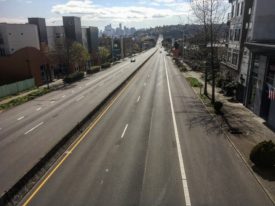Editor’s note: Guest contributor Hans Peter Meyer writes on community development issues from Courtenay, British Columbia.
I have a dream, and last year’s “official opening” of the One Spot Trail here in the Vancouver Island’s Comox Valley is part of its realization. The “developed” part of the trail is about 6 kilometres long. It’s a multi-use trail for walkers, cyclists, and horseback riding that parallels Condensory Road for part of its length, making a pleasant diversion through standing second- growth timber, then “ending” where the railway trestle used to cross the Tsolum River. Someday it’ll cross the river and head north.
I use quotation marks because the One-Spot Trail follows an existing railway right of way (RoW) that still stretches from the old log dump south of Courtenay, well into the Sayward Forest 120 or so kilometres north. Some stretches of the old Comox Logging RoW are still visible and in use as civic parkings, alley-ways, or urban walkways. Rural remnants are still walkable in some of the rural hamlets north and south of the city. But most of it is “lost,” buried in backyards or plowed into farmers’ fields, or hidden in the now twice logged-over lands that lie behind the settled strip of land on the east side of Vancouver Island.
There is a happy irony in naming this throughway the One-Spot Trail. The old One-Spot, a wood-burning locomotive, once pulled millions of dollars of timber out of this region. That was yesterday’s version of “rural economic development.” Today, the railway grade offers another type.
The irony deepens. The undeveloped part of the trail, as a relatively “protected” strip of land running through the heart of one of the world’s great forest ecosystems, is today—in places—one of the few places within walking distance of Courtenay where it’s possible to go for a long walk in a big Douglas fir forest.
We are slow on the uptake hereabouts. Maybe it’s living in the lap of so much natural wealth. It’s a commonplace, but three generations ago many people still believed that we’d never run out of first- growth forest. The wealth of timber seemed inexhaustible, and the wealth of work in the woods seemed unending. Now, relatively few people appreciate just how valuable our second-growth forests are becoming. Not in terms of timber, but as places where locals and tourists can get a sense of the former abundance of this place. It’s an aesthetic-spiritual experience, one that more and more people are valuing, as tourists, and as residents.
Living with so much natural wealth, it’s easy to take it for granted. Even to downplay what we have as “only second growth,” a pale shadow of the much vaunted “ancient forest.” For many around the world our wealth is plain to see: clean air and water, great swaths of unpaved and undeveloped lands, an amazingly resilient forest, a hospitable and temperate climate. Even our still relatively small settlements have some charm left to them (though our land use planning and development practices are an example of how little we regard the qualities of “charm” or “aesthetic” experience when it comes to built forms, housing). People who visit want to come back. And they want to deepen their experience of the things we take for granted. Like a walk in the woods.
It’s hard to know how much of an impact a trail can have on a scattering of rural hamlets. But, as tourists look for more active and “natural” ways to experience places, trails—and services for walkers and cyclists generally—start to look like a good and relatively inexpensive infrastructure investment.
About a dozen years ago bicycle touring started to emerge as a tourist activity on the Island’s Saanich peninsula. That area is laced with secondary roads and byways, has a rural agricultural feel, and links with ferries to Duncan and the Gulf Islands. The impression was that these were “cheap” or “budget” tourists. The reality was that they were spending over $100/day on accommodations, meals, and incidentals. Analysis showed that these cheap tourists were worth over a million dollars annually in the area.
Extraction is how we used to do rural economic development. Douglas firs. Salmon. Coal. Currently, we’re extracting raw land for large lot subdivisions. The challenge is do a different kind of “extraction,” to get as much “use” out of our landscape, forests, beaches, mountains, clean air and water, etc without diminishing its ability to sustain the high quality of life of those of us lucky enough to call this place home.
The dream of an extensive Comox Logging RoW trail is only part of the picture. In the backyards and backwoods of every Island community are hidden old railway grades. The Comox Logging RoW crosses several, including the Elk River right-of-way that connected Campbell River to the Quinsam River and Campbell Lakes valleys, the Bloedel Steward and Welch networks heading inland from Menzies Bay, the Rock Bay and Kelsey Bay rail lines that snaked into the White and Salmon River valleys, and so on.
To begin the work of mapping these connections, and then creating partnerships and low-key development may begin generating jobs and businesses in the rural communities that haven’t done well with the passing of yesteryear’s timber bonanza.
The One Spot Trail is only 6 kilometres long at this point, but it’s a great start. Meanwhile, I’m still dreaming. There’s a walk I want to do. From Royston to Sayward. About 130km. With a stop or two at a B&B along the way, at a pub (or two) for a beer. Maybe I’ll even do part of it on horseback. What a way to spend a week on Vancouver Island!
P.S. There is a growing body of research and literature on the economic benefits of trail systems for rural communities. A good place to start is the American Trails website.






